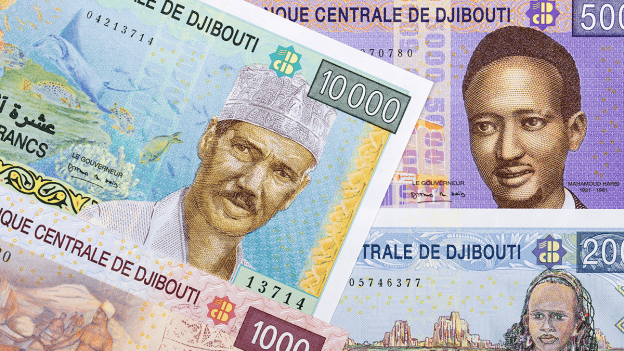Some countries have a surprising and unique origin. For example, the Djibouti and its Franc origin story is definitely unexpected. Looking at its location its a good indicator that it was carved out of a prior region. Djibouti is located on the coast of the Horn of Africa across from the Arabian Peninsula. Also it is strategically positioned to be close to key oil regions and marine shipping lanes. In the mid 1800s France came to dominated the area that includes today Ethiopia, Somalia, Eritrea and Djibouti. However, Djibouti has deep ports and an attractive environment that led to a significant international population. Also France was very interested to maintain control or influence over this area. Djibouti was the last to vote for independence from France, finally becoming the Republic of Djibouti in 1977. The US, France, Japan and China each maintain a significant presence in the country.
The Origins of the Djibouti Franc
Djibouti’s history of banknotes is not very long, but its few series are attractive. Before its independence, Dijbouti was called French Somaliland until 1967 and then the French Territory of the Afars and the Issas. It used French overseas banknotes, but in 1977, the National Banque issued the Djibouti francs. The 1977 series included 500, 1000 and 5000 denominations. In 1984, a 10,000 franc begins to circulate and the 500 converts into a coin. The 500 (P-36) maintains the same overall design concept as prior colonial French notes but the design highlight the range of Djibouti landscapes. The reverse shows the stern of a wooden ship highlighting the seafaring nature of the country. The 1000 franc has a nice scene of resting camels. Another unique feature of the Djibouti francs is that they have text in both French and Arabic.
Source: Banknote World Educational
The second series begins to circulate in 1997. The designs evolved away from French territorial concepts to African banknotes while keeping the use of bright, vibrant colors. For example, the 10,000 franc (P-41) follows a more typical split of areas between a rectangular area for the watermark, a middle area for offset backgrounds and images and an area for intaglio portraits. This note has a portrait of President Hassan Gouled Aptidon who took office in 1999. The reverse shows a detailed image of the Central Bank Building.
Source: Banknote World Educational
40 Francs Bring Much Attention
Djibouti issued a 40 franc commemorative in 2017 (P-46) that has been a highly collected banknote. It is a print by PWPW. They make high quality commemorative banknotes. The 40 franc commemorates 40 years of independence. The front shows a shark in a background of a coral reef. The Gulf of Eden and Red Sea area are popular as coral reef hotspots by scuba divers. The reverse shows multiple images related to the Port of Djibouti. The overall use of geometric design areas around the edges also add to the beauty and interest in this note.
You can purchase Djibouti banknotes by clicking here.
